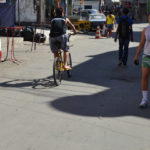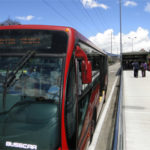
By Paula Santos and Nicolae Duduta Hosting major events such as the World Cup or the Olympic Games can serve as a catalyst for cities to carry out infrastructure upgrades and urban renewal projects. Back in 1992, Barcelona set the ...


While a debate continues about the future of biofuels, Brazil is currently facing an important decision for its own future. Ethanol from sugar cane emerged in the years 2000 as a potential alternative to fossil fuels and possibly a game-changer ...


More than 270,000 pedestrians are killed in run-ins with cars and other motor vehicles each year around the world. On Brazilian roads alone, over 10,000 pedestrian lives are lost each year. This staggeringly high number reaffirms the urgent need to ...


Picture yourself on a lazy Sunday afternoon cruising down San Francisco’s Market Street in one of the city’s iconic streetcars. You have a seat to yourself to peer out the window as the sun beats down over the Golden Gate; ...


Dear readers, Think you have what it takes to be a full-time intern blogger for TheCityFix? Apply to be our intern Writer and Blogger! If you can’t commit to a paid position in our Washington, D.C. office, please consider being ...


Buses began operating at a large scale by the year 1910, offering the advantages of route flexibility for routing, adaptation alongside the development of urban roads, and lower installation costs, as compared to railways. Efficient service and door-to-door service between ...


New York City has joined the ranks of U.S. cities now offering bike-sharing systems. Sponsored by CitiBank and launched on Monday, Citi Bike offers residents, commuters, and visitors to the “Big Apple” an additional mobility and urban connectivity option, in the form ...


“The South California towns, Los Angeles and Pasadena, are now connected by the strangest and most interesting of links-a magnificent, elevated cycle-way, with a smooth surface of wood, running for nine miles through beautiful country, flanked by green hills, and ...


Public transport is a core part of our daily lives. It is an economic driver — linking commuters to employment opportunities and bringing potential customers to retail and commercial establishments. It impacts our health, as modes of urban transport affect ...


If cities are to be more people-oriented, shouldn’t we work on sharing the space with each other? That’s the intention of the Bench of Friendship, upon which it is impossible to sit alone. Sponsored by the British-based Fisherman’s Friend and ...

Page 169 of 348« First...1020...168169170...180190...Last »